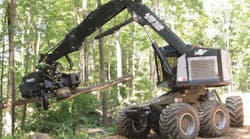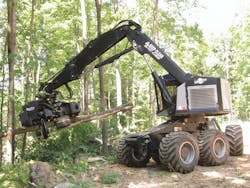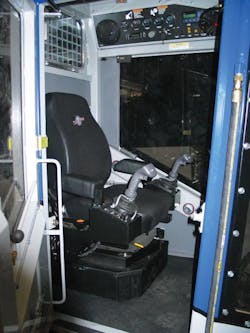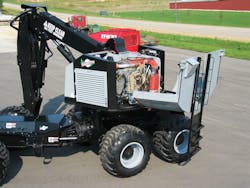Tree harvesting has come a long way from two lumberjacks standing at opposite ends of a gigantic saw, using brute strength to cut through the trunk. Hydraulic technology plays a huge role in today's forestry equipment, thanks to its combination of power density and reliability.
TimberPro's machines are designed with 360° continuous rotation cabs, allowing the operator to always face the work, whether over the front, back, or side of the machine. According to Jeff Huntington, the company's engineering support manager, "Our machines are more robust and a lot more stable than much of the competition's. This allows us to handle larger attachments and larger loads."
Getting started
Huntington notes, "The forwarders use many hydraulic controlled functions. An open-loop implement valve system controls the cab rotation through a small Bosch Rexroth hydraulic motor and gearbox. It also controls all the cylinders for main boom (up/down), stick boom (in/out), telescopic boom (in/out), steering, and grapple (open/ close and rotate). The closed-loop wheel drive is a hydrostatic system, consisting of a Rexroth pump and two Rexroth motors connected to a two-speed gearbox."
Operation of the machines is fairly straightforward — the operator uses electronic joysticks, handles with control buttons, switches, and an electronic foot control to send signals to an onboard IQAN system, developed by Parker Hannifin Corp., Cleveland. IQAN is an electrohydraulic management system that monitors operator inputs and converts these data to a usable electronic signal to control hydraulic valve and hydrostatic drive functions.
IQAN also communicates with other systems, including the machine's 300-hp Cummins diesel engine and multiple temperature and speed sensors. A Master Display Module (MDM) is connected to other control modules using CAN communication. The MDM displays data from these systems and also allows control of them. After receiving input from sensors and control input from the operator, IQAN sends out control signals to the proportional coils located on a Rexroth wheel-drive pump and Parker/VOAC control valves.
The closed-loop wheel drive system operates at 6000 psi. It includes a variable-displacement, reversible pump and dual variable-displacement hydraulic motors, all from Bosch Rexroth. The dual motors are attached to a two-speed transfer case that is connected to the front and rear axles through drive shafts. The transfer case reduces the speed of the hydraulic motors by two different ratios, depending on whether the operator has the gearbox shifted into high or low.
The implement system is openloop, with a working pressure of 4000 psi and maximum flow of 95 gpm. It contains a variable-displacement, load-sensing pump connected to a Parker/VOAC multi-section, load-sensing, pressure-compensated, directional control valve system. The valve sections communicate to the implement pump to demand needed pressure and flow through a load-sensing circuit. Both the pump and valve need this load-sensing feature to communicate together. The implement pump's swash plate angle is changed and only produces the needed pressure and flow that the valve asks for.
New design brings rave reviews
A recent redesign boasts many improvements over older versions of the forwarders. Troubleshooting has been improved by the use of a rear gull wing door with ladder. This offers mechanics a safe place to stand while working on the machine, and also opens up the entire hydraulic and engine compartments for easier access.
Thanks to the use of electronic engines and J1939 CAN communication to the IQAN control system, the machines can now display any errors, problems, or even fuel usage of the engine to the operator. The operator's cab was also improved for comfort by decreasing noise levels by 15 dB, locating all operator controls in short reach of the operator's hands, and adding an air-suspended operator's seat.
Problem solved
After finishing the machine, one major task was fitting the extra hydraulic hoses used when certain attachments were installed. The much smaller envelope used in the new design created man high-wear points on the hoses. Engineers solved this by moving the implement valve stack to a better location and changing how hoses were routed. Steel tube lines with hoses connected on each end were used in areas that were tight on space.
Huntington commented that one major benefit in the new design is a huge improvement in hydraulic cooling capabilities. "Cooling is a big problem with a lot of forestry machines, and because of location and size of a new oil cooler, this problem was solved."
Click here to watch a video of a TimberPro TF840 in action.




